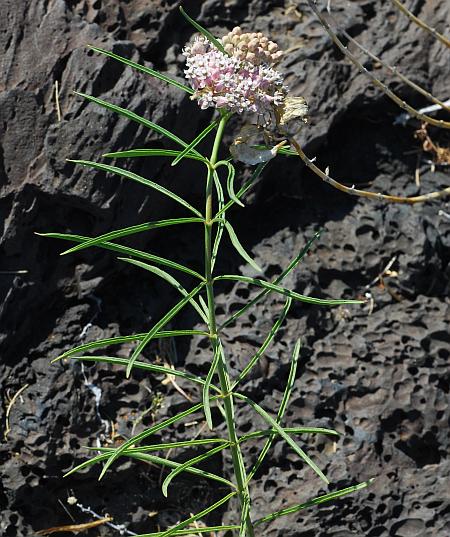Asclepias subverticillata (A. Gray) Vail
Poison Milkweed

Introduced
CC = *
CW = 3
MOC = 2
© SRTurner
Asclepias subverticillata (A. Gray) VailPoison Milkweed | |
 |
Introduced CC = * CW = 3 MOC = 2 |
© SRTurner |
|
Family - Asclepiadaceae Habit - Perennial forb from deep-set rhizomes. Rootstock sometimes woody near stem bases. Stem - Ascending to erect, to 90 cm, occasionally few-branched toward the tip and with axillary branchlets with pairs or clusters of short leaves in many of the main leaf axils, glabrous or sparsely short-hairy in longitudinal lines, with milky sap, with numerous nodes.
Leaves - Main stem leaves mostly in whorls of 3-5, sessile or nearly so. Leaf blades 2-12 cm long, 1-3 mm wide, linear, often folded longitudinally, the base narrowed or tapered, the tip narrowed or tapered to a sharp point, the margins curled under, glabrous or sparsely and minutely hairy.
Inflorescence - Axillary umbels, 2-8 per stem, mostly short-stalked, with 6-25 flowers.
Flowers - Calyx lobes 5, reflexed, glabrous or sparsely short-hairy, 1.2-2.5 mm long, narrowly lanceolate to ovate. Corolla lobes 5, reflexed, glabrous, white, occasionally slightly tinged with pink or purple, 3.5-4.5 mm long, elliptic. Gynostegium appearing stalked (the column visible below the bases of the hoods), pale green to white, the corona noticeably shorter than the tip of the anther/stigma head. Corona hoods 1.5-2.0 mm long, erect or ascending, attached toward their bases, broadly oblong in outline, the tips broadly rounded, the margins not toothed, the bases not pouched. Horns attached near the hood bases, extended conspicuously beyond the tips of the hoods and incurved over the anther/stigma head, linear, not flattened, tapered to a sharp point at the tip.
Fruits - Fruits 5-9 cm long, erect or ascending from erect to deflexed stalks, narrowly elliptic-lanceolate in outline, the surface smooth, glabrous or minutely hairy. Seeds with the body 6-8 mm long, the margins narrowly to somewhat more broadly winged, the terminal tuft of hairs white.
Flowering - June - August. Habitat - Railroads. Origin - Native to the southwestern U.S.; introduced in Missouri. Other info. - This southwestern species is rare in Missouri, thus far found only in one location along a railroad in St. Louis. It seems likely that the seeds were deposited there from a train inbound from western regions of the country. It is fairly common in its native range, around the Four Corners region of the southwestern U.S. It is similar to the far more common A. verticillata in appearance, but with the leaf nodes often containing small axillary branchlets. Photographs taken in Zion National Park, Washington County, UT, 9-2-2013, and near Lava Lake, Blaine County, ID, 7-19-2014 (SRTurner). |